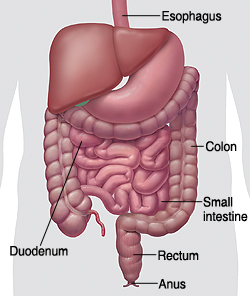When You Have Gastrointestinal (GI) Bleeding
Blood in vomit or stool can be a sign of gastrointestinal (GI) bleeding. GI bleeding can be scary, but the cause of the bleeding is usually not serious. Still, you should ALWAYS see a doctor if GI bleeding occurs.
The GI Tract
 The GI tract is the path that food travels through the body. Food passes from the mouth down the esophagus (the tube from the mouth to the stomach). Food begins to break down in the stomach. It then moves through the duodenum, the first part of the small intestine. Nutrients are absorbed as food travels through the small intestine. What is left passes into the colon (large intestine) as waste. The colon removes water from the waste. Waste continues from the colon to the rectum (where stool is stored). Waste then leaves the body through the anus.
The GI tract is the path that food travels through the body. Food passes from the mouth down the esophagus (the tube from the mouth to the stomach). Food begins to break down in the stomach. It then moves through the duodenum, the first part of the small intestine. Nutrients are absorbed as food travels through the small intestine. What is left passes into the colon (large intestine) as waste. The colon removes water from the waste. Waste continues from the colon to the rectum (where stool is stored). Waste then leaves the body through the anus.
Causes of GI Bleeding
GI bleeding can be caused by many different problems. Some of the more common causes include:
-
Hemorrhoids
-
Ulcer (sore on the lining of the GI tract)
-
Cuts or scrapes in the mouth or throat
-
Infection (bacteria or parasites)
-
Food allergies
-
Medications
-
Inflammation (swelling or irritation of the lining of the GI tract)
-
Polyps (growths of tissue)
-
Abnormal pouches in part of the GI tract
-
Tears in the anus
-
Nosebleed
Diagnosing the Cause of Blood in Stool
If blood is coming out in your stool, it may signal a lower GI tract problem. Bleeding from the lower GI tract can be bright red, or it may look dark and tarry. Occult blood can't be seen with the eye, but can be found in the stool on tests. To determine the cause, tests that may be ordered include:
-
Blood tests
-
Hemoccult test: checks a stool sample for blood
-
Stool culture: checks a stool sample for bacteria or parasites
-
X-ray, ultrasound, or CT scan: imaging tests that take pictures of the digestive tract
-
Colonoscopy or sigmoidoscopy: a test during which a flexible tube with a camera is inserted through the anus into the rectum to view the inside of your colon. This lets the doctor do a biopsy (take a tiny tissue sample).
Diagnosing the Cause of Blood in Vomit
Vomiting blood may signal an upper GI tract problem. To determine the cause, tests that may be ordered include:
-
Endoscopy: a test during which a flexible tube with a camera is inserted through the mouth and throat to see inside the upper GI tract. This lets the doctor do a biopsy (take a tiny tissue sample).
-
X-ray, ultrasound, or CT scan: tests that take pictures of the digestive tract
-
Upper GI series: x-rays of the upper part of the GI tract taken from inside the body
Call your healthcare provider right away if you have any of the following:
-
Bleeding from the mouth or anus that can't be stopped
-
Fever of 100.4°F or higher
-
Bleeding accompanied by lighheadedness or dizziness
-
Signs of dehydration (dry, sticky mouth; decreased urine output; very dark urine)





